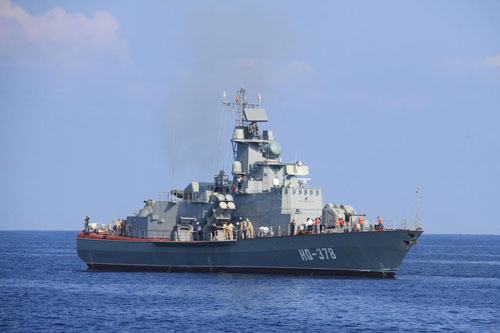Dual-use technology has been applied largely to industry development, especially defence industry. Therefore, studying to clarify its role and importance in defence industry development is really necessary.
The term “dual-use technology”, by its general definition worldwide, indicates the technologies that can be applied to designing and manufacturing both military and civilian products. Since technology to produce infantry arms and ammunitions is highly specialized, it is hard to combine it with production of consumer goods on the same assembly line. Meanwhile, production of types of military equipment for services and arms, for instance: military vehicles, radars, warships, warplanes, and so on can adopt dual-use technology. Technologies to design intercontinental ballistic missiles and rockets to launch satellites for civilian purpose share a lot of common features.
 |
|
Molniya missile ship manufactured by Vietnam |
In their development program of defence industry, countries worldwide tend to apply the most advanced scientific and technological achievements to military production. This can be the potential for economic and social development if we consider the requirements of dual-use right in the research and development stage. Hence, in many countries, law on defence industry includes detailed regulations on time limit to decode military technological achievements to serve purpose of civilian trade. Military interest sensitivity is the reason why in unilateral or multilateral international sanctions to control arms trade and military technology transfer always have stringent rules in order to embargo or restrict subjects who can access dual-use technology, and sphere of access. For the world’s largest defence corporations, strength in dual-use technology for military production not only helps firmly hold their advantage in the arms race but also becomes the key element to improve their competitiveness in the civilian commercial goods market.
As level of military technology development gets higher, the possibility to transform it into dual-use technology, benefits bringing added value and competitiveness becomes bigger. However, it is not easy to best promote dual-use technology’s advantage. We can take Former Soviet Union as a typical example. In spite of the fact that it had a strong defence industry and advanced military technology, its economy was always in a shortage of consumer goods, especially high-tech ones. This is a lesson on slowly applying military technology achievements to goods production for civilian purposes. Today, there is a comparison between the two development modes of defence industry by international experts: either invest in defence industry for military arms mass production which can be used for “hot storage” to serve the purpose of deterrence and combat readiness; or invest in military technologies (including dual-use technology) for “cold storage” to continuously develop new types of weapons. Choosing one of the two modes (or combine both of them) depends on each country’s viewpoint, concrete situation and condition in different periods. While it is hard to transform weapons from “hot storage” into civilian goods, dual-use technology and its stored materials can be directly used to satisfy demands of both wartime and peacetime. Thus, focusing on “cold storage” might lead to long-term and optimum results for both defence and economics.
Feasibility of implementation of measures for developing dual-use technology in defence industry in the upcoming time depends on our determination to overcome difficulties, challenges, and our ability to take chances to successfully conduct dual-use programs or investment projects. Additionally, in the upcoming time, national power of science-technology and industry should be effectively utilized to develop core technologies, and fields of technology that support manufacturing and assembling weapons. That will help us more proactive in including criteria of dual-use for the process of studying and developing a new technology. National status in the international arena, strategic partnerships, other countries’ gradually lifted sanctions, initial experiences in getting into international market of arms and military technology, Vietnam’s commitment to relevant international conventions are favourable conditions to help us more proactive in selecting methods, inviting competitive bid for each investment and development project for defence industry, ensuring best interests for the country including interests of defence dual-use technology to serve the cause of industrialization and modernization.
For the reasons above, the following are proposals to develop dual technology in Vietnam’s defence industry in the new period:
1. Long-term plan and orientation for products using dual-use technology which suit defence industry’s strength and competitiveness.
2. Investing in dual-use technology and promoting research and development of dual-use products.
3. Strengthening management and organization mechanism for dual-use technology.
4. Developing human resources in defence industry toward dual-use technology.
5. Carrying out policies to attract resources for dual-use technology at home and abroad.
Major General, Assoc. Prof, Dr. Doan Hung Minh
General Department of Defence Industry